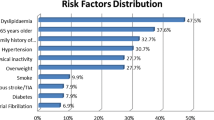Abstract
In order to determine the baseline knowledge of stroke among population (terminology, signs and symptoms, risk factors (RF) and attitude) to select the best target and message, prior to educational campaigns, a structured interview using close-ended questions was conducted by neurologists among 1000 users of several Primary Health Centers around our Hospital, randomly sampled. In our population 10.1% totally ignores the disease; of the remainder, 50% has a good knowledge of signs and symptoms and 37% of RF. To be a woman, (OR: 1.7; 95% CI: 1.2–2.5), the university education (OR: 6.6; 95% CI: 3.0–14.7), the age between 45 and 65 years (OR: 2.5; 95% CI: 1.3–5.0) and to have an afflicted relative (OR: 1.4; 95% CI: 1.001–2.0) are associated with a better stroke knowledge. If symptoms are transient, there is a trend to contact primary physicians (43.5%). Less than a quarter of our population have a good knowledge of the disease. Stroke is considered an emergency unlike TIA. The benefits of public education and the best message for each target population are discussed.
Similar content being viewed by others
References
Williams LS, Bruno A, Rouch D, Marriott DJ. Stroke patients' knowledge of stroke. Influence on time to presentation. Stroke 1997; 28: 912–915.
The National Institute of Neurological Disorders and Stroke t-PA Stroke Study Group Tissue Plasminogen Activator for Acute Ischemic Stroke. N Eng J Med 1995; 333: 1581–1587.
Furlan A, Higashida R, Wechsler L, et al. Intra-arterial prourokinase for acute ischemic stroke. The PROACT II study: A randomized controlled trial. JAMA 1999; 282: 2003–2011.
Katzan I, Furlan A, Lloyd L, et al. Use of tissue-type plasminogen activator for acute ischemic stroke. The Cleveland area experience. JAMA 2000; 283: 1151–1158.
Montaner J, Mauleon A, Vidal C, Molina C, Alvarez-Sabin J. Stroke: A stranger for the population. Rev Neurol 1998; 27: 943–947.
Matias-Guiu J. Neuroepidemiología. Barcelona: J.R. Prous, 1993.
Karlins M, Abelson HI. Persuasion. New York, NY: Springer Publishing Co.; 1970: 69–81.
Samsa GP, Cohen SJ, Goldstein LB, et al. Knowledge of risk among patients at increased risk for stroke. Stroke 1997; 28: 916–921.
National Institute of Neurological Disorders and Stroke. Brain attack: Stroke warning signs. Available at: www.ninds.nih.gov.
Dornan WA, Stroink AR, Pegg EE, et al. Community stroke awareness program increases public knowledge of stroke. Stroke 1998; 29: 288.
Alberts MJ, Perry A, Dawson DV, Bertels C. Effects of public and professional education on reducing the delay in presentation and referral of stroke patients. Stroke 1992; 23: 352–356.
Farquhar JW, Maccoby N, Wood PD, Alexander JK, Breitrose H. Community education for cardiovascular health. Lancet 1997; 1: 1192–1195.
Kothari R, Sauerbeck L, Jauch E, et al. Patients' awareness of stroke signs, symptoms and risk factors. Stroke 1997; 28: 1871–1875.
Pancioli AM, Broderick J, Kothari R, et al. Public perception of stroke warning signs and knowledge of potential risk factors. JAMA 1998; 279: 1288–1292.
Shelton JE, Gaines KJ. Patients' attitudes towards TIA. Virginia Med Q 1995; 122: 24–28.
Author information
Authors and Affiliations
Rights and permissions
About this article
Cite this article
Montaner, J., Vidal, C., Molina, C. et al. Selecting the target and the message for a stroke public education campaign: A local survey conducted by neurologists. Eur J Epidemiol 17, 581–586 (2001). https://doi.org/10.1023/A:1014581003849
Issue Date:
DOI: https://doi.org/10.1023/A:1014581003849




